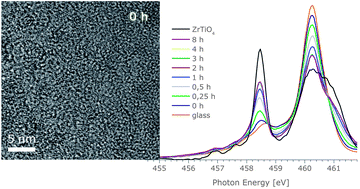ZrTiO4crystallisation in nanosized liquid–liquid phase-separation droplets in glass—a quantitative XANES study
Abstract
The

* Corresponding authors
a Leibniz-Institut für Oberflächenmodifizierung e. V, Permoserstraße 15, Leipzig, Germany
b Department of Geology, University of Toronto, 22 Russell Street, Toronto, Ontario, Canada
c IFW Dresden, P. O. Box 27 01 16, Dresden, Germany
d Otto-Schott-Institut, Universität Jena, Fraunhoferstraße 6, Jena, Germany
e Institute of Physical Chemistry, Bulgarian Academy of Sciences, G. Bonchev Str. Block 11, Sofia, Bulgaria
The

 Please wait while we load your content...
Something went wrong. Try again?
Please wait while we load your content...
Something went wrong. Try again?
T. Höche, M. Mäder, S. Bhattacharyya, G. S. Henderson, T. Gemming, R. Wurth, C. Rüssel and I. Avramov, CrystEngComm, 2011, 13, 2550 DOI: 10.1039/C0CE00716A
To request permission to reproduce material from this article, please go to the Copyright Clearance Center request page.
If you are an author contributing to an RSC publication, you do not need to request permission provided correct acknowledgement is given.
If you are the author of this article, you do not need to request permission to reproduce figures and diagrams provided correct acknowledgement is given. If you want to reproduce the whole article in a third-party publication (excluding your thesis/dissertation for which permission is not required) please go to the Copyright Clearance Center request page.
Read more about how to correctly acknowledge RSC content.
 Fetching data from CrossRef.
Fetching data from CrossRef.
This may take some time to load.
Loading related content
